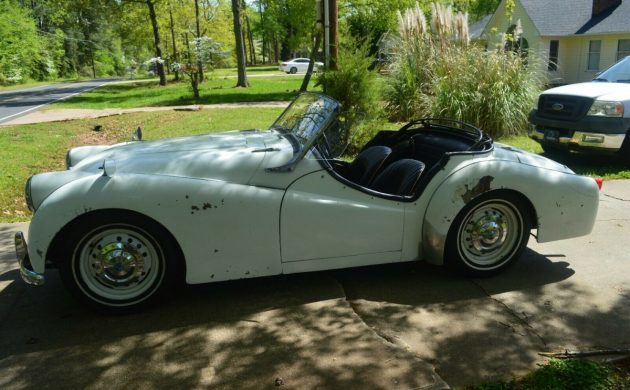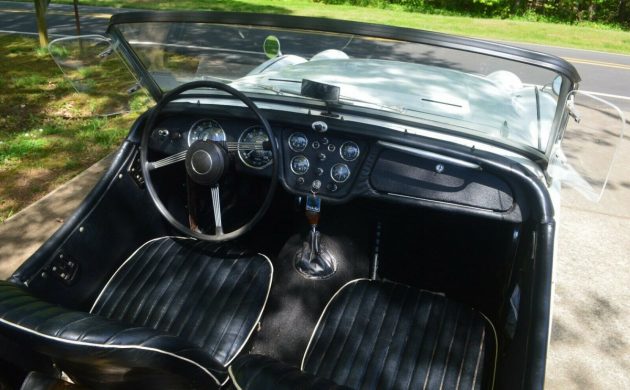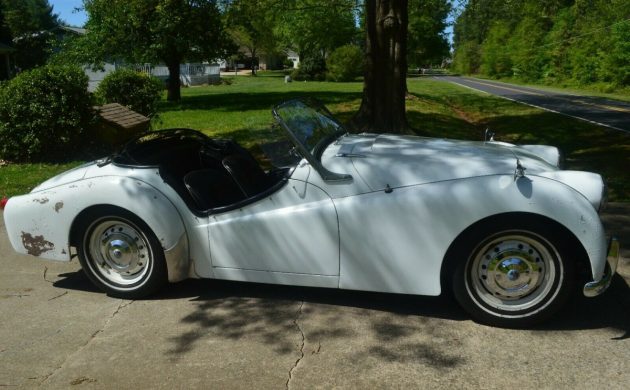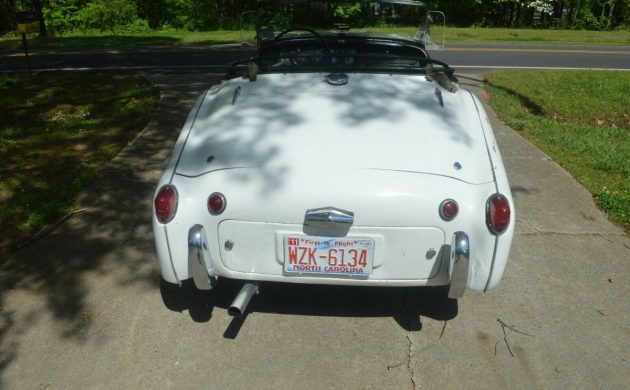It’s not often that we see old, original British steel in decent shape anymore, but in this case, it piqued our curiosity. It’s listed for sale here on eBay out of Mooresville, North Carolina. Let’s sit down with a spot of tea and take a look, shall we?
The Triumph TR3 were dreamt up by Standard-Triumph Motor Company in Coventry, England. The first one rolled off the line in 1955, and the last in 1962. They were built in four countries: England, Australia, Belgium and South Africa. A total of about 74,000 went to market, and apparently quite a few came to America. Its original sale price was around £1000, which equals approximately $30,000 today, so it would not have been the most affordable two-seater roadster at that time.
On the plus side, they were lightweight cars with 2-liter, 4-cylinder engines and four-speed gearboxes, putting out around 100 horsepower, and they could be had with an optional overdrive setup. At the time, a top speed approaching 170 km/h (105 mph) and a 0-60 time of about 10 seconds were recorded. Also, they were allegedly the first production cars to offer disc brakes as standard. In fact, Car And Driver liked these cars quite a bit, so much so that they published an article about them in the March, 1958 issue. They weren’t the fastest things on wheels, but people really seemed to like them at the time.
With this particular one, we really aren’t given much to work with in the way of descriptions, so we have to let the pictures speak their thousand words. The seller tells us that it runs, has the aforementioned overdrive, needs some body work, and has been garage-kept since 1970….but other than that, we’re on our own. 
Now, I’m by no means an expert on old European vehicles, but anyone can plainly see straight away that this car needs some restoration. Paint and interior work, for sure, and perhaps some cleanup of the engine compartment. To my untrained eye, it doesn’t look to have been modified, but then I’m looking at it from the perspective of someone just now learning about them while having a cuppa and researching for this article.
Objectively speaking, it sounds like it could be a really fun machine, even with its factory-installed quirks (like the heater controls under the bonnet and notorious British electrical system) but all things considered, it might be a decent deal overall. They’re including a bunch of spares and asking a Buy-It-Now of $22,500 which seems a bit optimistic to me, given that this kind of vehicle is not exactly highly-sought-after. For comparison, Hagerty values a #2 at $28 grand and a #3 at $17,000. That’s what I think of it, what do YOU think of it? Let me know in the comments!







When i was a kid a couple of young guys rented a house down the street,one of them had a tr3. What a car,i used to help him wash it and hang out when he worked on it. It was the coolest thing i ever saw. One day he came home with a camaro……….he traded in his tr3. I never spoke to him again
170 kilometers, not miles, per hour top speed. The TR3 made 105 mph. E-types just made 150 mph.
I stand, corrected. Thanks!
These sell regularly for $12 – $15K. As you noted, $22,250 is optimistic. I say it is overly optimistic and unrealistic.
Ugh, Grrrr. Just like Corvairs for sale and the inevitable Ralph Nader comments, why do we still have to hear about the British/Lucas electricals when a British car comes up? Most of these cars and their quirky electricals haven’t been produced in 40 years! Many improvements in the technology have been made in that time. If you expect electrical problems in something this old your best bet is to be smart and replace with an entirely new wiring harness, modern fusebox and relays. I know curmudgeons that would just as soon patch, scrape, burnish and fiddle with anything that carries a current and gripe about breakdowns. Refresh instead! The Chinese suppliers will thank you.
TR3s sold for the same price as the MG T series. No way someone in the ’50s would have paid an inflated price for one as could be proven that they sold every one that hit our shores. I know 2 people who bought them new for around the $2,000 range. Also, heater controls are on the dash. You do have to turn on the hot water supply valve on the engine (rear of the head) as the heater uses the same fresh air supply as the summer air vents. If you look at all the other British cars of the era you will see the valve sitting on top of the engine. As mentioned, they were very fast compared to most other cars.
I agree with Little_Cars….the predicable Lucas Electrics comments are just tiresome. 50 and 60 year old cars have 50 and 60 year old electrical systems and often need a little help. Yes, there were some poor design decisions sometimes, but they weren’t quite as bad as the legend goes. 80% of all issues can be down to poor grounding. Also – technology moves on. Electro-mechanical components are not as reliable as modern electronics, but solid state electronics weren’t available in the 1950s and 60s. I’m sure Standard-Triumph would have used them if they could.
it’s a phenomenon of the internet echo chamber, once a myth starts it grows by constant repetition. you wonder how many of the people who’ve read and repeated the joke have actually owned an old British car/bike and base their opinion on real experience.
anyway – any self-respecting gearhead who can’t troubleshoot British car electrics at home and make their classic reliable…should probably think about a different hobby…. one advantage of cars like this from the 1950s, there really wasn’t much electrical wiring anyway.
will admit I’m biased….having restored my own Triumph TR4….but it is reliable enough to be used regularly.
OK, back to this car…. seems a nice example, needing work but reasonably complete and original? I’d agree it is maybe a little on the expensive side…though I feel that the TR3 is a model that is only going to continue to go up in value over the coming years…. I see them in the next tier of cars that are going to ascend into the almost-unaffordable range. it seems like E-types shot up out of most “normal” people’s price range, so big Healey’s became the next most affordable option, then big AH got so expensive, I think maybe TR3 and MGAs are going to be the next ones to drift that way…. who knows? I do feel that anyone who has a chance to buy a nice TR3 at a sensible price today should see it as a good investment.
Agree with the Lucas comments. Lucas gets an automatic bad rap when the name is mentioned. Yes, multiple grounds deteriorate, but the other half of the electrical legend comes from bad work by Joe at the corner Sinclair who didn’t get the grounding thing and then rewired using all one color wire creating a nightmare for following owners. New harness solves a lot.
Cute car, and values are increasing for the small mouth TR2’s and 3’s, but I think this seller is widely optimistic about getting that kind of scratch for this little roadster.
Comes with a bunch of spares-good thing, you will need them. Sorry, couldn’t resist. My first job was at a BMC dealer. They had these problems when these cars were new. Friend of my fathers bought his daughter an MG during the 60’s, and he spent every weekend working on it. Hopefully, new technology can take care of some of the short comings. Little cars is right–new wiring and components! Good luck to the new owner.
Cheers
GPC
Interesting discussion on Lucas electrics. Over the year have had a ’62 MG Midget and ’66 MGB as daily drivers. Never touched the electrics on either one. Put 14,000 miles on the Midget the first year driving all over the country visiting relatives. These days, unless you are a die hard purist, get one of the many wiring and accessory kits and hook ’em up.
Love the period photo, Bob Hess. Back in the days when white sidewalls, side curtains and a hardtop on a Midget was not an unusual sight at all. What color was the car in the photo? I’m visualizing light blue. Thanks for the memory.
Nice little car, optimistically priced considering condition. Underhood looks all correct down to air cleaners and green handled turn off valve for heater. I do wonder if you can push a finger through the firewall under the master cylinder box and battery tray as it looks fairly corroded.
Little_Cars… Color is a mid range grey. Don’t remember the name but it was the only grey the Midgets and MGBs had. Looked good on the car. Bought a ’65 Porsche 356C years later the same color. I was surprised to find it and don’t remember seeing another one like it, especially since it matched the Midget. Was Air Force stationed on a Nevada Naval Air Station. Navy guys loved the color.
Farina Gray. Only offered in 1961-62. I know the Porsche finish you’re talking about also. The pair must’ve have been striking when all shiny and new.
Bought the Porsche used 10 years after the Midget. Never had them together but that would have been neat.